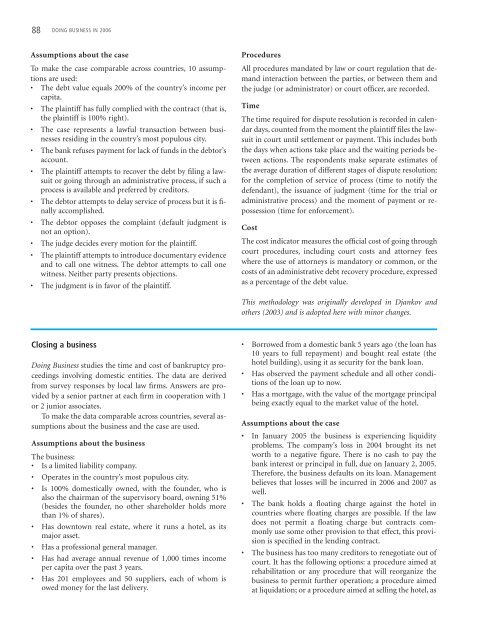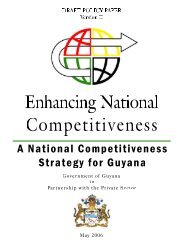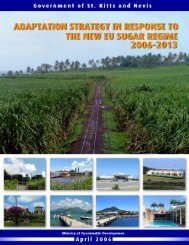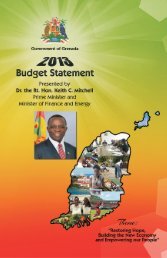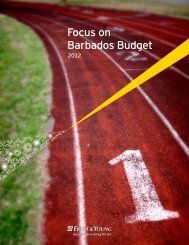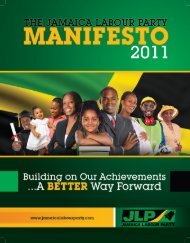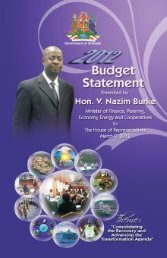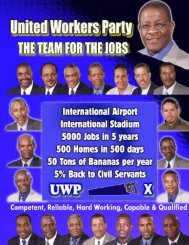Creating
Doing Business in 2006 -- Creating Jobs - Caribbean Elections
Doing Business in 2006 -- Creating Jobs - Caribbean Elections
Create successful ePaper yourself
Turn your PDF publications into a flip-book with our unique Google optimized e-Paper software.
88 DOING BUSINESS IN 2006<br />
Assumptions about the case<br />
To make the case comparable across countries, 10 assumptions<br />
are used:<br />
• The debt value equals 200% of the country’s income per<br />
capita.<br />
• The plaintiff has fully complied with the contract (that is,<br />
the plaintiff is 100% right).<br />
• The case represents a lawful transaction between businesses<br />
residing in the country’s most populous city.<br />
• The bank refuses payment for lack of funds in the debtor’s<br />
account.<br />
• The plaintiff attempts to recover the debt by filing a lawsuit<br />
or going through an administrative process, if such a<br />
process is available and preferred by creditors.<br />
• The debtor attempts to delay service of process but it is finally<br />
accomplished.<br />
• The debtor opposes the complaint (default judgment is<br />
not an option).<br />
• The judge decides every motion for the plaintiff.<br />
• The plaintiff attempts to introduce documentary evidence<br />
and to call one witness. The debtor attempts to call one<br />
witness. Neither party presents objections.<br />
• The judgment is in favor of the plaintiff.<br />
Procedures<br />
All procedures mandated by law or court regulation that demand<br />
interaction between the parties, or between them and<br />
the judge (or administrator) or court officer, are recorded.<br />
Time<br />
The time required for dispute resolution is recorded in calendar<br />
days, counted from the moment the plaintiff files the lawsuit<br />
in court until settlement or payment. This includes both<br />
the days when actions take place and the waiting periods between<br />
actions. The respondents make separate estimates of<br />
the average duration of different stages of dispute resolution:<br />
for the completion of service of process (time to notify the<br />
defendant), the issuance of judgment (time for the trial or<br />
administrative process) and the moment of payment or repossession<br />
(time for enforcement).<br />
Cost<br />
The cost indicator measures the official cost of going through<br />
court procedures, including court costs and attorney fees<br />
where the use of attorneys is mandatory or common, or the<br />
costs of an administrative debt recovery procedure, expressed<br />
as a percentage of the debt value.<br />
This methodology was originally developed in Djankov and<br />
others (2003) and is adopted here with minor changes.<br />
Closing a business<br />
Doing Business studies the time and cost of bankruptcy proceedings<br />
involving domestic entities. The data are derived<br />
from survey responses by local law firms. Answers are provided<br />
by a senior partner at each firm in cooperation with 1<br />
or 2 junior associates.<br />
To make the data comparable across countries, several assumptions<br />
about the business and the case are used.<br />
Assumptions about the business<br />
The business:<br />
• Is a limited liability company.<br />
• Operates in the country’s most populous city.<br />
• Is 100% domestically owned, with the founder, who is<br />
also the chairman of the supervisory board, owning 51%<br />
(besides the founder, no other shareholder holds more<br />
than 1% of shares).<br />
• Has downtown real estate, where it runs a hotel, as its<br />
major asset.<br />
• Has a professional general manager.<br />
• Has had average annual revenue of 1,000 times income<br />
per capita over the past 3 years.<br />
• Has 201 employees and 50 suppliers, each of whom is<br />
owed money for the last delivery.<br />
• Borrowed from a domestic bank 5 years ago (the loan has<br />
10 years to full repayment) and bought real estate (the<br />
hotel building), using it as security for the bank loan.<br />
• Has observed the payment schedule and all other conditions<br />
of the loan up to now.<br />
• Has a mortgage, with the value of the mortgage principal<br />
being exactly equal to the market value of the hotel.<br />
Assumptions about the case<br />
• In January 2005 the business is experiencing liquidity<br />
problems. The company’s loss in 2004 brought its net<br />
worth to a negative figure. There is no cash to pay the<br />
bank interest or principal in full, due on January 2, 2005.<br />
Therefore, the business defaults on its loan. Management<br />
believes that losses will be incurred in 2006 and 2007 as<br />
well.<br />
• The bank holds a floating charge against the hotel in<br />
countries where floating charges are possible. If the law<br />
does not permit a floating charge but contracts commonly<br />
use some other provision to that effect, this provision<br />
is specified in the lending contract.<br />
• The business has too many creditors to renegotiate out of<br />
court. It has the following options: a procedure aimed at<br />
rehabilitation or any procedure that will reorganize the<br />
business to permit further operation; a procedure aimed<br />
at liquidation; or a procedure aimed at selling the hotel, as


